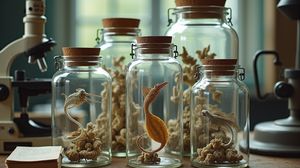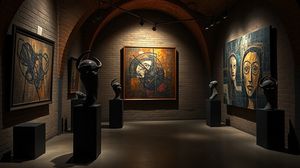
The Grant Museum of Zoology, nestled within the University College London, is an intriguing treasure trove for natural history enthusiasts. As one of the last remaining university zoological museums in London, it offers a rare glimpse into the world of zoological studies and the evolutionary narrative that has shaped the animal kingdom.
Founded in 1828 by Professor Robert Edmond Grant, it's an educational institution with deep historical roots. Grant, a pioneering comparative anatomist, established the museum to support zoological research and education, making it a historical cornerstone in the study of biology and zoology in the UK.
One of the museum's most fascinating features is the Micrarium, a one-of-a-kind display dedicated to minute specimens. This innovative exhibit showcases over 20,000 microscope slides, highlighting the significance of small organisms, which are often overlooked in larger natural history collections.
The museum is home to around 68,000 specimens covering the entire animal kingdom, from rare dodo bones to a Quagga skeleton, an extinct zebra-like mammal. The specimens are not just educational resources but also pieces of art, capturing the diverse beauty of Earth's wildlife.
A particularly unusual exhibit is the jar of moles, a glass container filled with preserved mole specimens, humorously encouraging visitors to count them all. This curious display challenges the perception of traditional museum exhibits, bringing in a touch of whimsy to scientific exploration.
Part of its charm lies in the unconventional layout and historic features, which evoke a Victorian-era curiosity cabinet ambiance. The eclectic atmosphere serves not only to inform but to inspire curiosity and wonder among visitors, making it a memorable stop for anyone interested in the natural world.

Making the Most of Your Visit:
Don't skip the Micrarium! It's a standout exhibit that's easy to miss but utterly fascinating once you step inside. The thousands of tiny specimens might just give you a whole new appreciation for the smallest members of the animal kingdom.
Spend some time with the jar of moles. It might seem quirky, but it's a great exercise in curiosity and observation. Try counting them for fun! It might even be a conversation starter with other visitors.
Keep an eye out for the dodo bones and the Quagga skeleton. These specimens offer a rare chance to connect with extinct species in an intimate way, making history feel very much alive.
Appreciate the Victorian charm! This museum is a throwback to the age of discovery with its old-school display cases and eclectic layout. Let yourself be transported to a time when collections were more about wonder and less about iPads.
Pace yourself. With over 68,000 specimens, there's a lot to see. Don't feel rushed, and let your curiosity guide you through the diverse and sometimes bizarre displays. It's a small space, but it's packed with intriguing finds.

Visiting Times & Costs:
The Grant Museum of Zoology, located at University College London in Bloomsbury, is indeed open to the public. Below are the key details regarding its operations:
- Opening Hours: The museum is typically open from Monday to Saturday, 1:00 PM to 5:00 PM. Please note that opening hours can vary during holidays or special academic periods, so it's advisable to check in advance if you're visiting during such times.
- Entrance Fee: Entry to the museum is free of charge, which makes it a splendid option for those keen to explore without any associated cost.
- Accessibility: The museum has made efforts to ensure accessibility for individuals with mobility impairments. There is step-free access to the entrance, and many areas within the museum are accessible. However, given the historical nature of the building, visitors may encounter some narrow passages or areas that are not fully optimized for wheelchairs. It is recommended to contact the museum directly for specific accessibility queries or to discuss special requirements.
These aspects make The Grant Museum of Zoology an accessible and intriguing destination for anyone interested in exploring zoological specimens in a historic university setting.

Address & Map:

Nearby:























